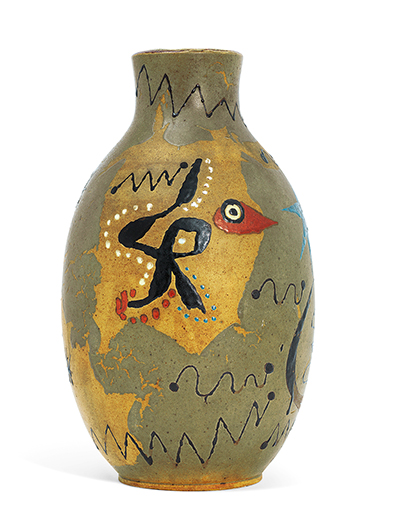Joan Miro loved to produce ceramics during an extended period in which he designed several hundred different items. He would call upon the services of others to help out with the technical production work, allowing him to concentrate more on the artistic side.
Pre-historic artistic styles, the like of which we all remember from studying cave paintings, are present within many of the vases that he put together during the 1940s. The specific vase in front of us here is dated at around 1941-1944 and is instantly recognisable as having come from Miro's hand. He would visit other studios in order to make use of the specific tools needed for this type of work, and it would never have been worth purchasing it all himself, particularly as he also needed advice on the process itself (that said, eventually a colleague would create a kiln for him within Miro's studio, after realising how passionate Miro was about this medium). Within this vase we find several eye shapes, plus diagonal lones and small circles, which continue a connection to cosmology which runs through much of his work. The artist applies thicker paint to create something similar to lettering, and then dots paint alongside it. His limited palette is reduced to red, black and white, though the vase itself came in a combination of grey and light brown.
There were some artists who would actually mould the vases themselves before adding designs on top, but most would simply make use of items already fired by others and tended to prefer just being able to focus on the artistic, decorative touches. Miro was someone who wanted to become involved in a large number of different techniques and mediums, meaning it would simply be unrealistic for him to attempt to learn all of the finest details about each one whilst also continuing to work productively. Miro's vase here shows an example of his early ceramic work, but he would continue to output all manner of vases and plates for decades to come, as well as hand painting natural items such as pebbles and anything else he found lying around in the natural world. He already had developed a form of iconography which could be translated across different mediums, and so enjoyed strengthening his brand into new areas.
Miro would work alongside Josep Llorens Artigas and Joan Gardy Artigas, father and son, in order to quickly understand as much about ceramics as was needed. He never attempted to match the specialist knowledge of these men, and modestly understood the role that he was playing within the ceramics world. They would build a strong relationship over many years, with the Artigas family helping to eventually build him a kiln within his own studio, once they realised that this was much more than a fleeting interest. In recent years there has been a greater attempt to fully document his work within this medium and a catalogue raisonne of it has been realised, with details around 440 works in total. There maybe more added in the future, but that publication certainly feels like a key moment in the world better understanding the ceramics of Joan Miro.




